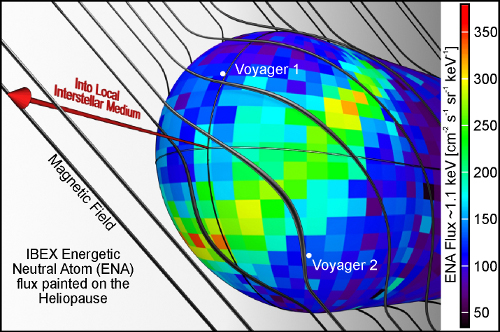IBEX, the Interstellar Boundary Explorer, was never designed to visit the regions it studies. Indeed, the spacecraft, launched in October of 2008, is in Earth orbit and a highly elliptical one at that, with an apogee of 322,000 kilometers and a perigee of 16,000 kilometers. But from that vantage IBEX is able to study and map the boundary between the heliosphere and true interstellar space. It does this by detecting energetic neutral atoms of hydrogen (ENAs) produced at the heliosheath, helping us understand the effects of the solar wind as it collides with interstellar materials.

The encounter between solar wind and the interstellar medium causes ENAs to be scattered in all directions from the heliosheath — those that pass near the Earth are what IBEX detects, and the spacecraft scans overlapping strips of sky to build up a 360-degree map. It was last October, a year after launch, that we learned from the first IBEX map that the interstellar boundary was a more lively place than anticipated. Expecting to see gradual variations at system’s edge, project scientists discovered a narrow, bright ribbon of emission in the ENA map, one that diverged from previous theoretical models of the region. And now we learn from the second IBEX map that an unusual ‘knot’ feature in the ribbon, the brightest hotspot at higher energies, seems to be unraveling.
Image: This graphic illustrates one possible explanation for the bright ribbon of emission seen in the IBEX map. The galactic magnetic field shapes the heliosphere as it drapes over it. The ribbon appears to trace the area where the magnetic field is most parallel to the surface of the heliosphere (the heliopause). Credit: SwRI.
The hotspot appears to be diminishing and spreading out along the ribbon. Here’s David McComas (Southwest Research Institute) on the matter:
“What we’re seeing is the knot pull apart as it spreads across a region of the ribbon. To this day the science team can’t agree on exactly what causes the knot or the ribbon, but by comparing different sky maps we find the surprising result that the region is changing over relatively short time periods. Now we have to figure out why.”
Indeed. What the ENAs measure is the strength of the interactions in the heliosheath. We now know that those interactions are far more variable than previously thought. To be sure, the large-scale structure of the ribbon appears to be stable during the six-month period between maps, but lower emissions at the ribbon’s polar regions and that oddly diminishing ‘knot’ snag the attention. Clearly, we have much to learn about the interactions between the heliosphere and interstellar space, that region so critical for our own survival since it shields the inner Solar System from the majority of galactic cosmic ray radiation.
Until recently, the interstellar medium encounter zone within the heliosheath was anticipated to be several billion miles thick. The unexpected variations in emissions seen by IBEX paint a different picture, causing us to speculate that the solar wind and the interstellar medium interact in a much thinner layer. We should learn a great deal more as the mission continues, particularly if IBEX moves into an extended mission that would take it into times of greater solar activity.
From a future technology standpoint, the more we learn about the solar wind, the better we’ll be able to evaluate magnetic sail concepts that some have suggested could use that wind to propel a spacecraft to the outer Solar System and beyond. Whether such propulsion is feasible depends not only upon the strength of the solar wind but its variability, factors about which IBEX can be informative as we flesh out our knowledge of the ‘bubble’ that contains the Sun and the planets.
The paper is McComas et al., “Evolving outer heliosphere: Large-scale stability and time variations observed by the Interstellar Boundary Explorer,” Journal of Geophysical Research Vol. 115 (2010), A09113 (abstract).



Nice point about magnetic sails and the heliosphere’s boundary zone. An important data point will be the behaviour of a mag-sail encountering that region from the outside – for example as it arrives at another star system.
Interesting… I wonder what this will come to mean?
It seems that scientific investigation almost always leads to things being more complex than they seem at first.
How much has already been discovered about the intricate and important differences on both sides of our heliospheric boundary! There logically are differences of the medium within the heliospheres of different systems according to the star sizes and types, and what their immediate galactic environment holds. Ambitiously looking beyond the Local Bubble, the interstellar environment changes in at least the density of matter outside its bounds. Successors to IBEX will work to understand these regions as well. Any considered starflight would need to have a preliminarily chart of these paths.
Just a thought: could IBEX be ‘repurposed’ to perform similar observations of the heliosheath around alpha centauri? (proxima?)